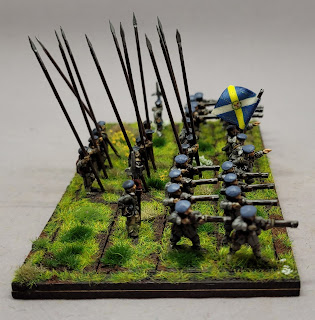Belvoir Castle dominates the landscape around the Vale of Belvoir, so it doesn't take much to see why the Normans built the original castle on the site, nor does it take too much working out to why they named it 'beautiful view'. Of course, if you are wondering how to pronounce it, the locals pronounce it 'beaver'.
The current 'castle' is a Regency house in a castle style, surrounded by a landscape envisaged by Capability Brown*.
The original castle had fallen into ruin by Tudor times, and had been rebuilt by Thomas Manners, 1st Earl of Rutland. It is this second incarnation of the castle that became a thorn in Parliament's side.
Belvoir was ideally located to protect the route from Oxford to Newark, the garrison used the castle as a stronghold from which to sally forth and disrupt Parliament's machinations in Lincolnshire, and Newark.
The castle was owned by John Manners, 8th Earl of Rutland a Parliamentarian and Covenanter. In January 1643 one of 'his gentlemen', Sir Gervase Lucas, facilitated the opening of the gates to Royalist troops, who quickly over ran the castle. Lucas would become governor of the castle, and his garrison would become known as the
Belvoir Cormorants, an apt description of their raiding techniques.
King Charles would spend the night here on route to Lincolnshire.
.JPG) |
| A young Charles, a dark unlabelled portrait at the bottom of the 'stairway of the Earls' |
The Earl gave permission for the burning of Belvoir village in order to clear the approaches to the castle.
Sydenham Poyntz would lead the siege efforts in October 1645, over running the outer defences and cutting off the water supply. The castle would eventually fall in February 1646. Lucas was given terms which allowed his garrison to march out of the castle with drums, colours and arms. They would march to Lichfield to bolster the garrison there.
The castle would be razed by order of Parliament in 1649. A new 'castle' would be started in 1654, work being completed in 1668. This castle would be remodelled/rebuilt in a gothic revival style - work beginning in 1799. It is this castle that we can visit today.
What's there today?
The castle is still the family home of the Duke of Rutland, and it is not uncommon to see him around the estate. The approach to the castle is, understandably rather steep, explaining why this location was picked for a castle.
The regency home immediately makes you wonder what is of interest to the Civil War anorak afficiando? Venture inside and you'll find a number of Civil War related artefacts and portraits.
You enter the castle through an entranceway flanked on either side by row upon row of brown bess pattern muskets (the castle is a treasure trove of early British Army artefacts, dating from the Seven Years War onwards), into what is called the 'guard room'.
.JPG) |
| The guard room is dominated by portraits of the Stuarts and a number of flags - including this First World War Kriegsmarine ensign. |
There is an impressive amount of militaria here; look closely and you will see hidden away some possible Civil War era cuirasses (hard to confirm as they aren't very accessible to view - unlike the highly polished French Napoleonic ones on the fireplaces), and a rather splendid buff coat tucked away in the corner (late C17th).
There is a beautiful example of Papal Guard half armour from the early part of the C17th.
Leaving the guard room behind you start up a flight of stairs proper and are faced with a cannon flanked by two suits of armour. The suit on the left is most likely Civil War vintage, bearing a proving mark (ignore the lower legs, they appear to be a Victorian addition to make the armour look, well, more suit of armour like). I'm not so sure about the suit on the right, looks possibly older.
 |
| Just ignore the Victorian lower legs |
.JPG) |
| Charles II after Van Dyck |
Following the tour route around the castle you will encounter a number of portraits of Charles I, a young Charles II, and a display case with a pile of musket balls found in the grounds.
.JPG) |
| Charles I by Edward Bower |
As is obligatory at such places, there is a gift shop and tearoom.
.JPG) |
| Civil War era finds from the grounds, incongruously displayed next to a modern 50p (cropped out of view - this is a Civil-War-centric blog after all) |
Postcodes for SatNavs
Belvoir Castle NG32 1PE* Brown's vision was never fully utilised, and what had been 'built' was overgrown and neglected; the discovery of Brown's original plans were used to recreate Brown's landscape. The work was documented by Alan Titchmarsh for Channel 4. The first episode is available on YouTube (sadly the rest of the series isn't available on either 4OD or YouTube).
If you enjoyed reading this, or any of the other posts, please consider supporting the blog. Thanks.
.JPG)
.JPG)

.JPG)
.JPG)
.JPG)















Comments
Post a Comment